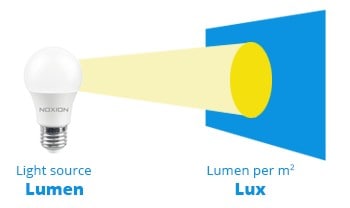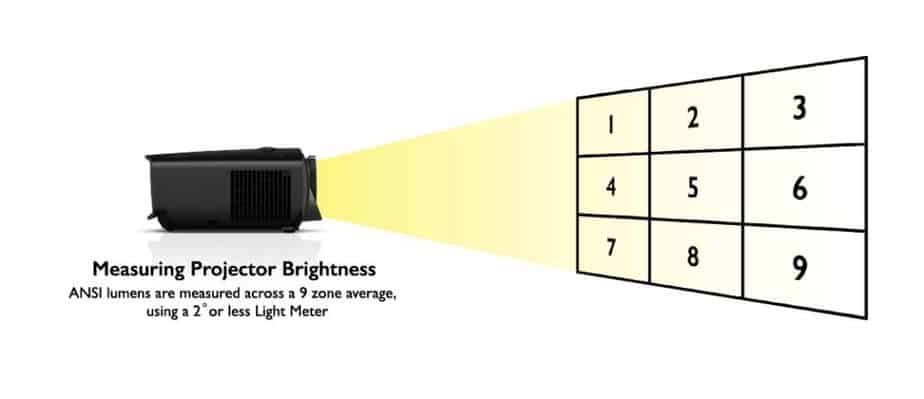As consumers become more sophisticated, there’s a need to have a greater knowledge of specifications for products. This is particularly true when it comes to consumer electronics, including projectors. Understanding what these terms mean is essential, considering the numerous variations in terms of quality specifications, features, and pricing of these devices.
Within the home theater market, one thing that consumers must know more about is brightness. When you understand what different units of light involved in ensuring that your projector offers better clarity, you can make an informed choice. In this regard, let’s examine lux vs. lumens projectors and learn more information about projector image brightness.
The term “brightness” that is used here is subjective and does not apply to optics. In discussing light, experts typically refer to “luminance.” But in this article, we attempt to simplify it and make it simple to comprehend.

Lux: What is Lux?
Lux is the term used to describe brightness across the surface area or one (1) lumen per the area. Photometry is the study of light. Lux measures the intensity (as the human eye perceives) of light on the surface.
Keep your eyes open. Did you feel a little lost by the term “photometry”?
Wonderful if you didn’t. However, if you do, this is what it signifies. Photometry is measuring light in relation to what our human eye perceives brightness.
Another reason to explain the term “lux” is that it refers to an International System of unit (SI unit) for measuring the illuminance (the whole luminous flux incident on a unit surface area).
Thus 1 lux equals one luminous flux per square meter 1 lux equals 1lm/m2.
Lumens: What Are Lumens?
The quantity in visible light the source radiates is referred to as Lumens. It’s the power that is perceived of light that is emitted from the source. Lumens are also the SI unit used to lumens measure luminous flux.
For example, that when the overall luminous flux is one (1) lumen is when one (1) candela of the intensity of a light source radiates at the angle of one steradian.
Hence, 1 lumen(lm)=1 candela(cd) / 1 steradian(sr).

Comparing Lux and Lumens: What Wins?
Let’s discuss the distinctions between lux and lumens and the commonalities they have in common. Let’s begin by highlighting the similarities they share, lux and lumens are both SI units for projector brightness.
They both determine the brightness the light source emits, but in two different ways. In contrast, lux measured as the amount of light as it disperses over a certain space. Lumen refers to the amount of light that comes from the source taking into account the sensitivity of the human.
If you take measurements of the lux and lumen from an fixed source and you measure it from a fixed location, the lumen will be the same even as lux decreases when you travel further.
Lumens vs. ANSI Lumens
There are a variety of specifications and features that you’ll need to consider before purchasing the projector. One that is often overlooked is what is known as the lumen quality. In the above explanation you will realize that it is how much brightness that the projector produces. The brightness of the projector is vital since it impacts how the image quality displayed by the projector.
Concerning lumens one of the issues that cause confusion to people can be ANSI lumens. Certain projectors provide this information as being more precise than lumen observation. With ANSI lumens they are able to measure it is possible to determine the luminous flux is measured through more precise methods and has many variables.

The older projectors typically only provide lumen measurement however they’re often not accurate. The latest projectors such as those that are used in home theaters offer ANSI lumens. This is more accurate and can be quantified. The information you get will be more trustworthy when you choose to purchase the purchase of a particular projector.
How to Measure Light Output in a Projector: Lux Vs. Lumens Vs. ANSI Lumens
The projector’s brightness and projector light produced can play an important part in the determination of the quality of images projected.
But the most important issue is what is the best way to measure brightness?
You can measure them in the lux, lumen, and(/or) ANSI lumen. These measurements are all connected with brightness. Brightness that is produced by projectors. Although they do have some similarities, they are also different in certain ways.
How Many Lumens a Projector Needs?&
The choice of the best projector for brightness is dependent on the way you intend to make use of it. To be clear there are three aspects to think about. These are the contents, ambient light, and resolution. A cumulative analysis of these variables can give an estimate about the number of lumens your projector will need.
The material or content that you intend to project affects how number of lumens you need. The business projector used for presentations will require fewer lumens. If you’ll be using it to power use in your home theater system, the number of lumens varies.
- Business or Portable Minimum 1500 lumens is sufficient for personal and professional use.
- Home Theatre Minimum 2000 lumens for the projector to be used for projection of television or film.
- Gaming A minimum 2 000 lumens is recommended if you are planning to make use of the projector predominantly to play games.
If you are only using a projector to use at school or for work that’s fine. 1500 lumens suffices. However, if you are planning to use it to be used for the purpose of a home theater, then you must start at 2000 lumens regardless of the other variables. The amount should be increased after having took into consideration other specs like throw ratio, lux and contrast, input capability as well as other factors.
Beyond the content, it is important to be aware of the resolution. In the case of home theaters the standard resolutions include 1080p as well as 4K. Gaming consoles typically use 1080p resolutions. For the majority of portable projectors, they usually only come with 840×480 resolutions. These factors are crucial in addition to the lumens because they guarantee that the projector gives an image that is clear.
Do not forget to consider your ambient lighting. The setting in which you project can have a huge impact on your choice of lumens. It is directly affecting brightness in the end. In terms of ambient light, consider the screen size as well. These two factors will determine the amount of lumens you should ensure that your projector is equipped with enough brightness for excellent viewing.
Final Words Lux vs lumens projector
If you are a user of projectors You must be aware of the specifications for the projector. Understanding which specifications are the essential, considering the numerous ways each specification affects the experience of viewing.
This article has explained the most important ideas in relation to projector brightness as one of the requirements of projectors. The article will help you in understanding the brightness the projector needs to be. Once you have a better understanding of the different units that represent what is the light output of projectors (lux, lumens, ANSI lumens) it is possible to choose the projector that offers better views.
The comparison of the three units that measure projector brightness, the lux as well as lumens shows the fact that these units are different. They also have something the same. The only thing they have in common being that they determine the brightness that a light source produces. So the lumens are crucial in relation to the light output when choosing the ideal projector.
